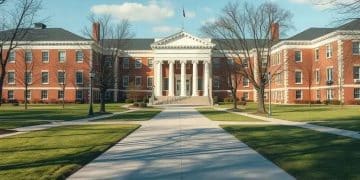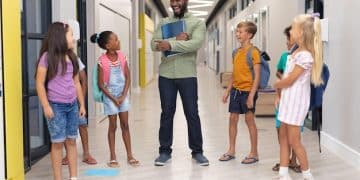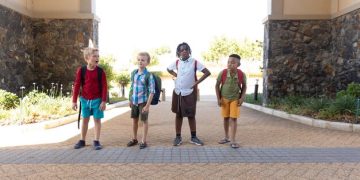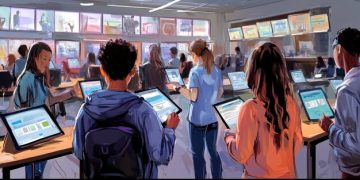Cuts in education department workforce: what it means for students

Cuts in the education department workforce lead to reduced student support, larger class sizes, and a decline in academic performance, emphasizing the need for innovative solutions to maintain educational quality.
Cuts in education department workforce often spark concern among parents and educators. How do these changes influence the quality of education and student success? Let’s dive into the implications together.
Impact of workforce cuts on classroom resources
The impact of workforce cuts on classroom resources is significant and concerning. With fewer staff members, schools struggle to maintain the same level of support and resources for students. This issue raises questions about how the quality of education can be preserved.
Effects on Available Resources
Reduced workforce means less assistance for teachers and students. Teachers may find themselves overwhelmed, leading to a decline in the attention each student receives. Furthermore, vital programs or materials may be cut, affecting students’ learning experiences.
- Fewer teaching aides means increased teacher workload.
- Decrease in funding for classroom materials.
- Reduction in extracurricular programs.
Classroom Environment Challenges
As resources dwindle, the classroom environment changes. Students may face larger class sizes, making it harder for them to engage and learn effectively. Moreover, teachers may find it challenging to address individual learning needs. This growing challenge calls for innovative solutions to support students.
Schools are attempting to adapt to these changes, often relying on community support or alternative funding sources. However, such measures may not be enough to fill the gaps left by significant cuts. Stakeholders need to advocate for adequate funding and resources to ensure that every student can succeed in a supportive learning environment.
Ultimately, addressing the impact of workforce cuts requires collaboration from educators, parents, and policymakers. Only through collective action can we ensure that students do not suffer due to these necessary yet challenging budget decisions.
Long-term effects on student performance

The long-term effects on student performance caused by workforce cuts can be profound. As schools lose qualified staff, students often face challenges that impact their learning journey and future opportunities. These cuts can lead to academic struggles and decreased motivation among students.
Academic Achievement Decline
When there are fewer teachers and support staff, students may not receive the individualized attention they need to thrive. This can result in a decline in academic achievement. Larger class sizes can overwhelm teachers, making it difficult to provide quality instruction.
- Reduced instructional time on core subjects.
- Increased dropout rates as students disengage.
- Lower test scores and overall academic performance.
Emotional and Social Consequences
Besides academic performance, the emotional and social well-being of students suffers. With less adult support available, students may struggle with feelings of isolation. Those who need extra help, like students with learning disabilities, might not receive the necessary resources to succeed.
Over time, these factors can contribute to a negative outlook on education as well. Students may start to view school as unwelcoming or unhelpful, which can hinder their growth and development. Engagement in school activities also declines, leading to a disconnect from the school community.
Addressing the long-term effects of workforce cuts is vital for schools. Finding innovative ways to support students despite budget shortfalls can help mitigate these challenges. Collaboration with community resources and engaging parents can play a crucial role in this effort.
Alternative solutions to workforce reductions
Exploring alternative solutions to workforce reductions becomes essential as schools face budget challenges. With fewer resources, creative approaches can help maintain educational quality and support for students.
Utilizing Community Resources
One effective way to counter workforce cuts is to tap into community resources. Schools can partner with local organizations and businesses to provide additional support. These alliances can offer volunteers, donations, or mentorship programs.
- Local non-profits can assist with tutoring and extracurricular activities.
- Businesses may sponsor educational events or provide funding for resources.
- Community members can volunteer their skills and time in classrooms.
Implementing Technology in Education
Leveraging technology is another promising solution. Online learning platforms can augment classroom instruction, allowing teachers to focus on individual needs. With the right tools, students can access a variety of learning resources beyond the school’s physical limitations.
Using technology enables schools to maximize their impact. Teachers can create blended learning environments, where students engage with digital content while receiving necessary guidance. This approach enhances flexibility and tailored instruction.
Additionally, training teachers to effectively use educational technology ensures that resources are used efficiently. Ongoing professional development helps educators stay updated on best practices, further supporting their students despite workforce challenges.
Engaging parents in the conversation is vital. Schools can hold workshops to educate parents about supporting their children’s education at home. This connection fosters a stronger community and encourages a collaborative effort to overcome the effects of workforce reductions.
Ultimately, by exploring alternative solutions, schools have the opportunity to adapt to changing circumstances. These calls for innovation not only benefit students in the short term but also lay the groundwork for a more resilient educational system in the future.
Voices from educators on the changes

Listening to the voices from educators on the changes brought by workforce cuts is crucial in understanding their impacts. Teachers and school staff are on the front lines, witnessing firsthand how these changes affect students and the educational environment.
Concerns About Student Support
Many educators express concern regarding the reduction of available support for students. With fewer teachers and staff, it becomes challenging to provide individualized attention. Many feel that every child deserves support tailored to their needs, and cuts hinder this goal.
- Teachers report larger class sizes leading to less one-on-one time.
- Support staff cuts mean fewer resources for students with special needs.
- Emotional and social support for students is dwindling.
Impact on Teacher Morale
Teachers also share feelings of frustration and burnout as responsibilities grow without adequate support. Many feel overwhelmed by the increased workload, which can lead to decreased morale. When teachers are unhappy, this sentiment can easily trickle down to students.
Furthermore, constant budget cuts can create a sense of instability, making it hard for teachers to feel secure in their roles. This uncertainty can detract from their teaching focus and impact their effectiveness in the classroom.
Some educators suggest that open lines of communication with administration can help address their concerns. Discussions about how to adjust to these changes may lead to better outcomes for both teachers and students.
Ultimately, capturing the voices of educators provides valuable insight. It emphasizes the need for decision-makers to consider the on-the-ground realities when making budget cuts, ensuring that students’ needs remain a priority.
FAQ – Frequently Asked Questions about Workforce Cuts in Education
How do workforce cuts affect student performance?
Workforce cuts can lead to larger class sizes and less individualized attention, which often results in a decline in academic performance.
What can schools do to support students despite workforce reductions?
Schools can engage community resources, utilize technology for online learning, and foster parent involvement to help support students.
What do teachers feel about the impact of workforce cuts?
Teachers express concerns about increased workloads, burnout, and reduced support for their students, which can negatively affect their morale.
Why is it important to listen to educators’ voices regarding school changes?
Educators provide valuable insights about the practical effects of policies, helping to inform decisions that impact student learning and support.





